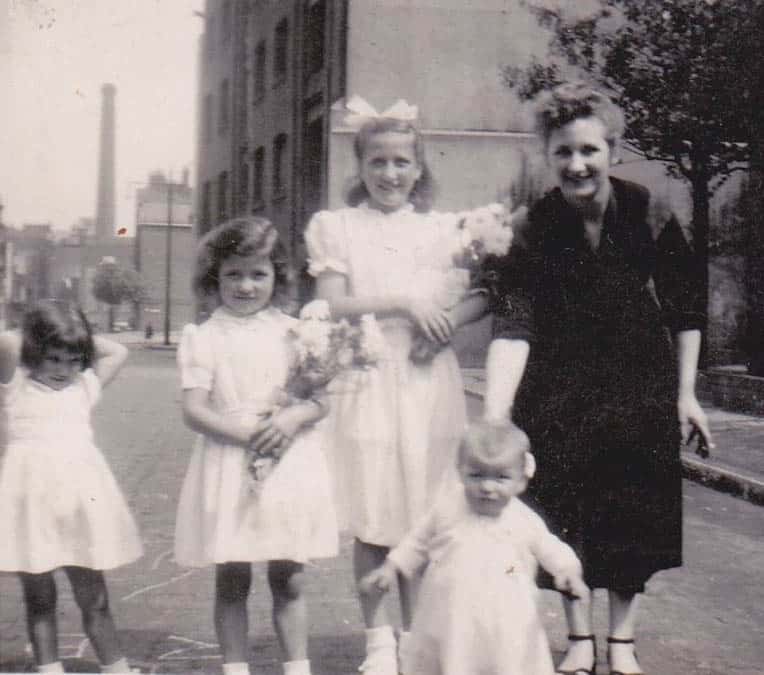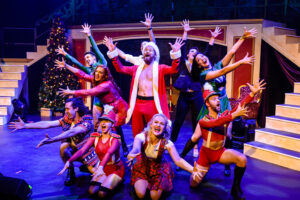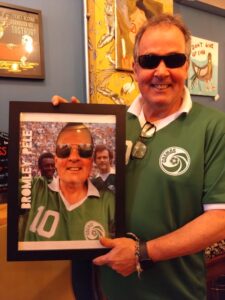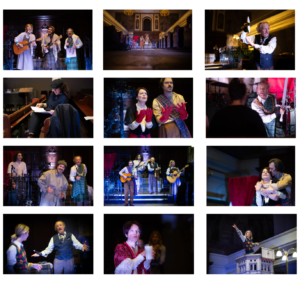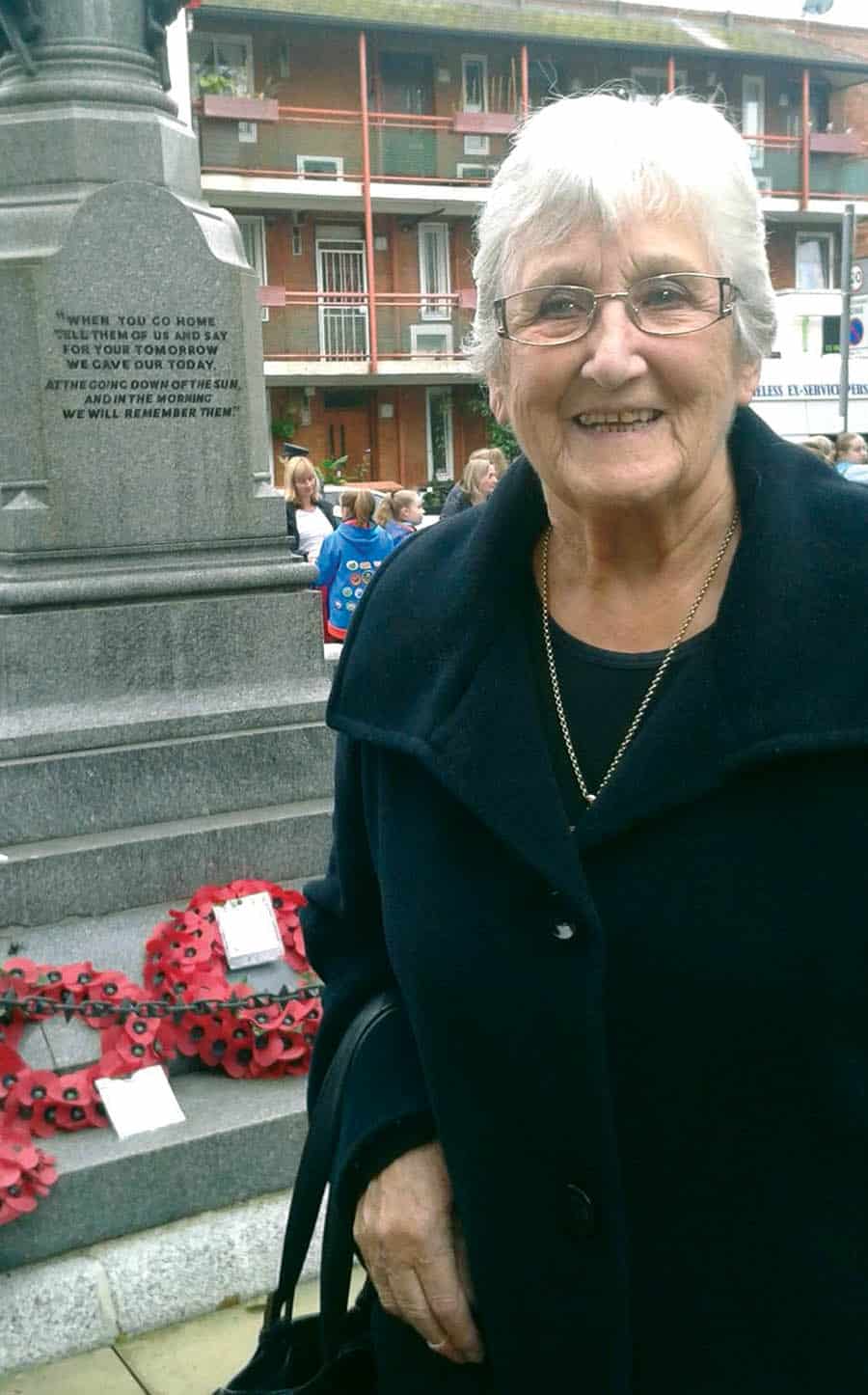
Kathy Donovan was born in St Olave’s Hospital in 1932, the eldest of five sisters and two brothers. Her parents, Bridget and Jim, had just moved into a one-bedroom flat on the brand new Millpond Estate. “They were better than the older blocks of flats in Rotherhithe and Bermondsey ‘cos they had inside toilets and a proper bathroom. None of that sitting in a tin bath in front of the fire like you hear old people talking about,” says the 86-year-old. “But we only had hot water in the winter when the fire was going; in the summer my mum had to heat up a copper and then get buckets of hot water out to pour in the bath, which meant only the first one in got the clean, hot water.”
As more and more siblings came along (Peter and Jean died while very young) the family continually moved into bigger flats in the same block on Bermondsey Wall East, eventually stopping at No. 20: a three-bedroom flat on the top floor. But with seven in the house, it was still crowded. “I suppose it was hard back then, but because I was the oldest I never had to wear hand-me-downs like my sisters.”

Life, though, through children’s eyes is far rosier than an adult’s. “Where we lived felt like the posh part of Rotherhithe with the new flats, the river on one side and Southwark Park on the other, where I played a lot,” she recalls. “You had to have a grown up with you to go in the Rose Garden back then, so it was exciting to go in there without getting caught by the Parkie; we used to run through from one side to the other as a dare!”
Her maternal grandparents were immigrants: Albert from France and Mary from Ireland. Her father was a stevedore in Surrey Docks all his life, while her mother did a variety of jobs. “During the war she worked at Lloyds: the tin factory at Dockhead, but when my brothers and sisters came along she had to do part-time work, so did early morning office cleaning.” Kathleen remembers her mum leaving at 4am and then coming home to get them all up and ready for school.
Young Kathy’s first school – and all the little Donovans – was St Joseph’s in Paradise Street (Now in Gomm Road). “I remember one teacher – a Miss Donovan, coincidentally – who used to punch you in the back if you weren’t moving quick enough for her!”At the outbreak of war the whole school was evacuated to a Catholic school in Burgess Hill. “After the Blitz all the kids came back to Bermondsey for a while, but then the doodlebugs started so me and my brother Jimmy were evacuated to Scotland. It wasn’t nice being evacuated alone, as I was not treated very good by the people who took us in. It was better when we all went together, with my brother Jimboy and my Mum.”
Being a Catholic was evidently quite exciting in those days. “Catholics had the Procession; Protestants didn’t have a procession in their schools.” For the annual Procession, the schoolchildren used to march around the Rotherhithe streets carrying a statue of Our Mary. “The Catholic houses used to put little altars in their windows, and candles, and the priest would bless the house with holy water as the Procession went past.”
Kathy then changed to Notre Dame School at the Elephant. “I got there on a scholarship after passing the Eleven Plus. I was the first person to get one at St Joseph’s,” she remembers with pride. “The best thing, though, was not getting any more punches in the back from Miss Donovan ‘cos she thought it was all down to her that I got the scholarship, but it was because I was clever!” Kathy got to her secondary school on a tram but what she remembers most about trams was when they were being taken out of service. “On the day the last 68 tram came along Jamaica Road hundreds of people came out to see it off, and everyone put a penny down in the tramlines to get it squashed flat or bent by the tram as it took its final journey, to keep as a souvenir.”
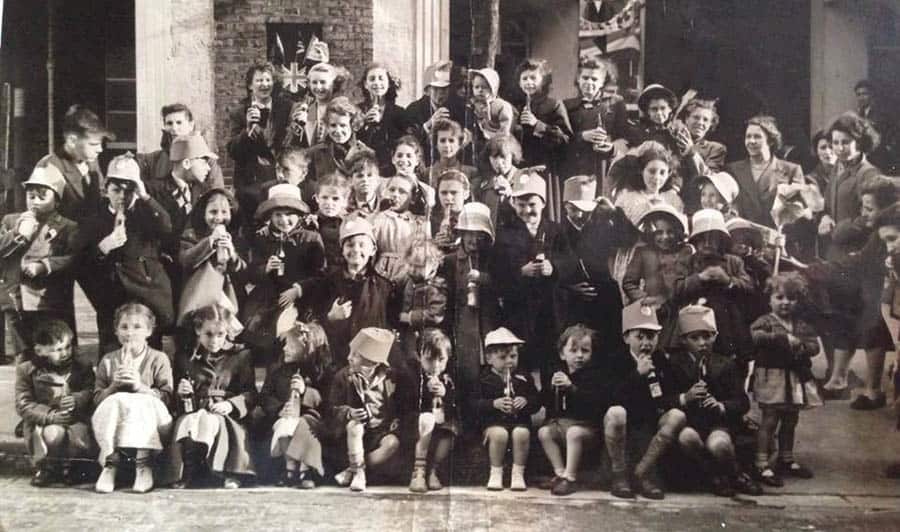
The end of rationing was also a day that stuck in the mind of the woman who went through the Blitz and separation from her family. She says, “I think most people, especially children, remember the day sweets came off rationing, because every local sweet shop completely sold out. Imagine a shop that sold nothing else but sweets but with just empty jars on its shelves!”
School ended at 15, when she started a job in Bermondsey Street. Her wage was £2 10s 0d (£2.50) and she gave her mum £1 10 0d (£1.50). “The best thing about it was the smell of the fresh bread from the bakery next door,” she says with a nostalgic look on her face.
Kathleen’s teenage years were then spent dancing. “I was often up the Harp Club in New Cross, and then rushing home on the tube to Rotherhithe so I wouldn’t get a wallop off me dad… I met my first husband, Butchie Burkett, at a dance at English Martyrs church hall in Walworth so we always went dancing. We also went dancing around the bandstand in Southwark Park when they had a band there. “I’m dancing in Mary Gosling’s painting of the bandstand, which my son bought for me.” It hangs on her living room wall.
Southwark Park was also where Kathy’s mum used to work as a park-keeper. “My mum and most of her sisters were Parkies and she loved it; she’d look after all her grandchildren there in the school holidays.”
Kathy came of age in the ‘50s. “When I got married we lived with my mum for a while but then got a place in Park Buildings but that marriage didn’t last and I met my second husband, Tommy Holland, who fought at Pegasus Bridge with the Red Berets in the D Day landings, in the Two Brewers.” Tommy, sadly, died from cancer within two years.
Hop picking was the family holiday for most Bermondsey people, and the Donovans were no exception. The aunts, cousins and neighbours were also on Day’s Farm with them, just outside of Yalding, so it was a lot of fun. “Three of my sisters were born round about the same time,” begins Kathy. “Bridget, May 20th; Wendy, May 31st, and Janet on June 1st. We called them “Hopping Babies” because my mum always came back pregnant from hopping in September!”
As the austerity of the war years receded and the ‘60s arrived, there seemed to be more money about. Family holidays meant going to Pontins or a caravan somewhere, and eventually, when cheap flights became available, to Spain.
“But you never forget the hopping days,” she says wistfully.
Kathleen’s mum, Bridget, lived all her life within half a mile of Ainstey Street where she was born, until she passed away, aged 87, at Ronald Buckingham Court, sheltered housing for the elderly behind the Adam and Eve in Brunel Road.
In 1958, Kathy and her two sons move to the newly-built Silwood Estate, then to Osprey Estate when that opened in 1970. These days she lives in an apartment block for over-55s in Sidcup and between cruises she keeps herself busy at a weekly exercise session, bingo and lunching with friends, neighbours and family.
This article is brought to you by our sister publication The Bermondsey Biscuit and Rotherhithe Docker



